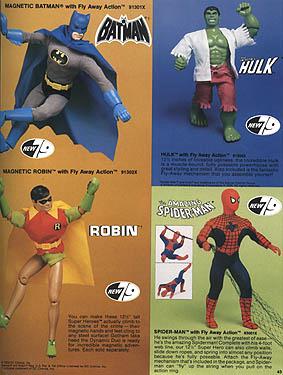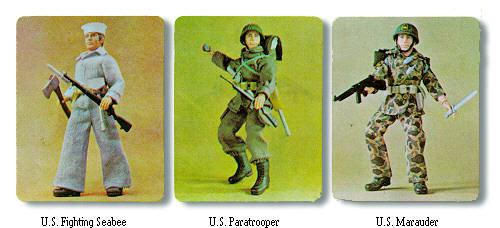Mego Museum: And is that because it's a rotational mold?
NK: Yeah, the mold is called the lost wax procedure, they make a clay sculpting, then they make a plaster of it. They split the plaster and they make it in wax, then they surround the wax with soft copper. The copper is joined into one solid piece of the whole head.
The inside is from the wax, the wax melts when the copper is welded, now you have an empty mold. The liquid vinyl is then sprayed into that mold and is either split or the head is pulled out of the mold.
Mego Museum: It was just pulled out? I've noticed there is no flashing on the Mego heads.
NK: Yeah, labor was so cheap back then that we'd have had flashing removed by hand. It's still the same method today.
Mego Museum: Do you recall any other TV shows from the seventies that Mego was considering doing?
NK: I don't really recall, (I remember) Happy Days the first year was really a bomb but then Fonzie emerged and so I don't know how many pieces of the other characters we sold, there wasn't a lot but the Fonzie doll sold like crazy for a year.
Mego Museum: You said to me that playsets, the bulk of that business was in the catalog retailing?
NK: Yeah, Toys R Us would carry them, Sears and Penny's would put them in the catalog and of course in those days, there were toy departments year round. To my memory if sold more than 100,000 pieces of any playset it was a lot..
NK: (Playsets) had very little tooling, it was all cheap so you could make a profit on 25,000. In fact, some of them were made (in the United States) the plastic parts would be made in the orient and the sheet vinyls were made in a factory in the bronx which no longer exists.
Mego Museum: I love Mego Playsets, some of the gimmicks are very interesting. Do you recall the Wayne Foundation, it's supposed to have a elevator that supposed to glide smoothly, it just doesn't work.
NK: You'll have to speak with my people (laughs).
Mego Museum: 25 year old complaints need not be addressed, another question I need to ask is about the alter ego sets you made for Monty Wards. What was the story with those?
NK: We had a good relationship early on with Montgomery Ward, there was a fellow there in charge of the catalog named Frank Lockhart a really nice man who was a close friend with David Abrams and he needed a special, catalog people always needed a special.
So we made them up for (MW), they were secondary at best but you had to supply your catalog houses.
Mego Museum: So there was never any idea of doing more with the Secret Identity concept?
NK: No, not at all. I'm not even sure I ever saw them, they may have been shipped right out the orient to Wards.
Mego Museum: We hear rumors that the loss of Star Wars drove mego crazy and sent them on a frenzy of acquiring sci-fi licenses?
NK: No, we had all these properties way before Star (Wars) happened, pne of the problems with Star Wars is they showed it to us in February and the movie broke in the summer.
While the other (properties) may have been released a year or so later, they were shown a year and a half to two years before the film came out, so there was a double whammy there.
Mego Museum: So by that time, you may have already closed the Star Trek the motion picture deal?
NK: The year that Star Wars came out or '78, we took Buck Rogers as a favour, we had Star Trek, which we thought was gonna be big and we had Black Hole. I am not sure why we took Black Hole, (I guess) because it was Disney.
Mego Museum: You produced a lot of toys for those lines, why was it specifically 3 û and 12?
NK: By that time, if you didn't both sizes, someone else would do it. We had the bodies, it cost us nothing. It was just good business, if the (buyer) bought the 12 great, if he bought the 8 even better. It didn't matter to us, we had bodies in every size.
Mego Museum: Did the Licensors have any say in the final product?
NK: No, the size was the bodies we had, the molds we had.
Mego Museum: Why was the nine inch body used for the Flash Gordon line ?
NK: The body was created because of Big Jim? I think that the time that size was created, maybe it was Big Jim that got hot?
Mego Museum: Probably would have been Big Jim?
NK: It probably was Big Jim that got hot, it didn't last very long but it was hot, so we (gave it a shot with 9 figures) and we used that body for Muhammad Ali.
Mego Museum: Right, Muhammad Ali and the Doctor Who lines.
NK: It's a funny thing, I don't have any memory of Who..
Mego Museum: It was only sold in England, how was creating toys for foreign countries handled?
NK: We had a sales guy, one guy who handled Europe, cause there was (usually) only one big distributor each country. He came back to the factory and said The guys in England want Doctor Who and so they made it.
I would close the license and they would make the goods and I would never see it, it would ship right out of the orient.
NK: Have you ever seen the western figures?
Mego Museum: Yes, I have..
The illustrations on them, were done by a guy who was in the same class as Frank Frazetta and Boris, a guy named Ken Kelly
Mego Museum: Did he do the Monster boxes too?
NK: Yes, He was (one of the most) talented Illustrators around, self taught by the way. I never had to send anything back, it was always right on the money.
Mego Museum: I love those illustrated boxes, it is on the reasons I collected Mego. I promised my friend I'd ask this question, in the first WGSH (1973) catalog, there are two Superhero adventure sets, what happened to those?
NK: I looked at them and I remember them distinctly, I don't remember why they weren't made.
Mego Museum: When I look at them, those weren't reused Captain Action pieces were they?
NK: They very well could be, you can't see in the photos but they are handmade boxes, all pasted together, they were comps. Why they weren't made, I don't know.

I can give you a fairly good guess and that is, when we made the prototypes and we showed them to the retailers, if they said Yes, we did it and if they said No, we didn't.
Mego Museum: You guys would make anything you could sell
NK: I think what we brought to the table is some real creativity but if they didn't buy it, it was ridiculous making it. One thing about the toy industry that is interesting is that you have twin level marketing, you first have to convince the retailer to buy it and if you can't get it on the shelf, you can't get it done, it's that simple. It hasn't changed to this day, one of the reasons about all the talk of TV budgets was to get it made, so you had to make something the buyers would bite on and then you had to remember that there was a kid who had to buy it. Often you had to show buyers things that weren't going to make it just to get there interest and some of that stuff seems to have come to light.
Mego Museum: Back to Silk Screened suits, the first versions of the (Supergals) had silk-screened boots and belts, yet the later editions had plastic ones?
NK: We wanted to get it to the counter and the other parts had to be tooled, so we didn't wait for the tooling.
Mego Museum: You just went ahead and released them with the intention of changing them later?
NK: Right, running changes, we were big on those. One of the things that people are discovering today which I find amazing, is keeping it fresh. The (President of ) Jakks pacific said to me (recently), "The way we are doing this, bringing out new characters every three months, this is the first time this has ever been done", and I wanted to say "Excuse me?"
Mego Museum:: Mad Monsters: Had you approached Universal about using their monsters?
NK: As you pointed out, that we occasionally did things that we didn't have to pay royalties, to increase our margins.
Mego Museum: That stuff didn't normally survive, is that because of the lack of TV promotion to keep it alive in the marketplace?
NK: That really was it, there reason for being so that we didn't have to promote them, they were public domain and we took our shots, whatever we sold, the profit margins were so much higher. The cost to get into them was comparatively minor.
Mego Museum: Removable Mask Robin, a lot of them that show up come with yellow sleeves and shorts, do you recall that being a problem?
NK: I don't recall it, I'm sure it probably reached me. (The Factory) probably ran out of material and used something in the meantime and we were short goods and we had to supply certain people so we used the next best thing.
Mego Museum: How well did the 12" figures do?

NK: I remember them, they didn't do very well.
Mego Museum: Why was Magnetic Spiderman rejected?
NK: (12") Spiderman didn't sell that well, he just didn't do that well I remember working on it but if you say it wasn't made, I guess it never sold.
Mego Museum: You made two other 12" Spiderman, the web shooter and the regular ones. (editors note, maybe this is why the 12' Magnetic was rejected)
NK: Those were slated for promotions for TV, I wish I could tell you why (Magnetic Spidey wasn't released) I remember seeing the thing. In fact, if you had asked me if I made it, I would have said Yes, we did all of them. It was a real battle between both parties in those days of course,(Marvel and DC)
Mego Museum: How did you juggle the competitive forces between Marvel and DC?
NK: If we did something for this guy, why didn't we do it for them? You go tell Stan Lee that nobody wanted a Spidercar...Have you ever met Stan Lee?
Mego Museum: No I haven't
NK: To Stan Lee, Spiderman is alive. He would get personally insulted (when you told him a Spiderman car wouldn't sell).
Mego Museum: The Lion Rock World War Two Heroes....
NK: (interrupts) Like Doctor Who, it took place just like that. Why do another GI Joe? It would have just made (Mego) another knock off artist importer which we were not interested in being at that point, we had far surpassed it. So they were made for Europe to go against Action Man and it was made in the Factory, somebody said to (the European Manufacturing agent) Why don't you make WW2 heroes? and that's how it was done. So if there any any here, it's a big surprise.

Mego Museum: Does anyone have the rights to the Mego body now that the company is gone?
NK: No, it's now public domain. In fact, if you had the original tooling today it would be useless, old fashioned by today's standards.
Mego Museum: Mr Kublan, thank you for this great interview.
NK: Pleasure talking to you Scott